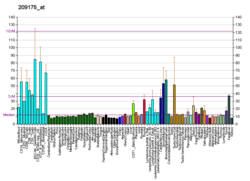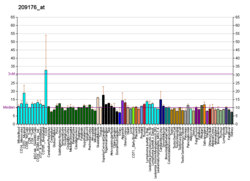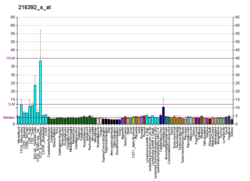SEC23IP
SEC23-interacting protein is a protein that in humans is encoded by the SEC23IP gene.[5][6]
COPII-coated vesicles are involved in protein transport from the endoplasmic reticulum to the Golgi apparatus. The protein encoded by this gene was identified by its interaction with a mouse protein similar to yeast Sec23p, an essential component of the COPII. This protein shares significant similarity with phospholipid-modifying proteins, especially phosphatidic acid preferring-phospholipase A1. Overexpression of this protein has been shown to cause disorganization of the endoplasmic reticulum-Golgi intermediate compartment and Golgi apparatus, which suggests its role in the early secretory pathway.[6]
References
- 1 2 3 GRCh38: Ensembl release 89: ENSG00000107651 - Ensembl, May 2017
- 1 2 3 GRCm38: Ensembl release 89: ENSMUSG00000055319 - Ensembl, May 2017
- ↑ "Human PubMed Reference:".
- ↑ "Mouse PubMed Reference:".
- ↑ Tani K, Mizoguchi T, Iwamatsu A, Hatsuzawa K, Tagaya M (Aug 1999). "p125 is a novel mammalian Sec23p-interacting protein with structural similarity to phospholipid-modifying proteins". J Biol Chem. 274 (29): 20505–12. doi:10.1074/jbc.274.29.20505. PMID 10400679.
- 1 2 "Entrez Gene: SEC23IP SEC23 interacting protein".
Further reading
- Li H, Xie B, Zhou Y, et al. (2006). "Functional roles of p12, the fourth subunit of human DNA polymerase delta". J. Biol. Chem. 281 (21): 14748–55. doi:10.1074/jbc.M600322200. PMID 16510448.
- Shimoi W, Ezawa I, Nakamoto K, et al. (2005). "p125 is localized in endoplasmic reticulum exit sites and involved in their organization". J. Biol. Chem. 280 (11): 10141–8. doi:10.1074/jbc.M409673200. PMID 15623529.
- Gerhard DS, Wagner L, Feingold EA, et al. (2004). "The status, quality, and expansion of the NIH full-length cDNA project: the Mammalian Gene Collection (MGC)". Genome Res. 14 (10B): 2121–7. doi:10.1101/gr.2596504. PMC 528928. PMID 15489334.
- Ota T, Suzuki Y, Nishikawa T, et al. (2004). "Complete sequencing and characterization of 21,243 full-length human cDNAs". Nat. Genet. 36 (1): 40–5. doi:10.1038/ng1285. PMID 14702039.
- Strausberg RL, Feingold EA, Grouse LH, et al. (2003). "Generation and initial analysis of more than 15,000 full-length human and mouse cDNA sequences". Proc. Natl. Acad. Sci. U.S.A. 99 (26): 16899–903. doi:10.1073/pnas.242603899. PMC 139241. PMID 12477932.
- Mizoguchi T, Nakajima K, Hatsuzawa K, et al. (2001). "Determination of functional regions of p125, a novel mammalian Sec23p-interacting protein". Biochem. Biophys. Res. Commun. 279 (1): 144–9. doi:10.1006/bbrc.2000.3846. PMID 11112430.
This article is issued from
Wikipedia.
The text is licensed under Creative Commons - Attribution - Sharealike.
Additional terms may apply for the media files.






